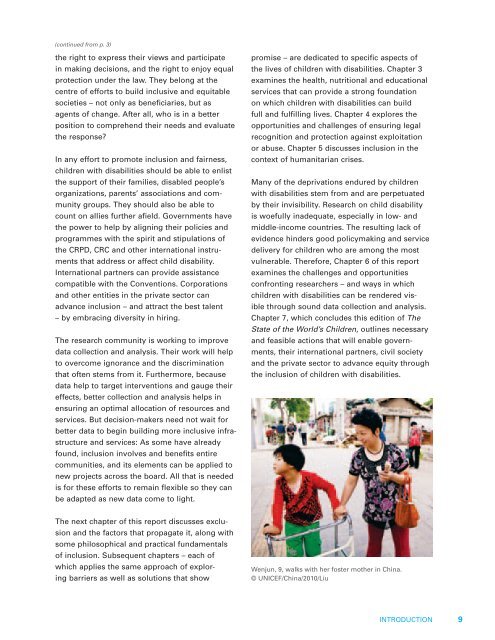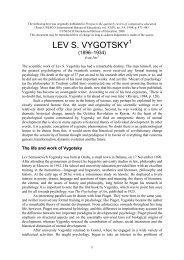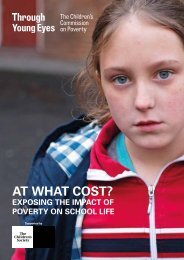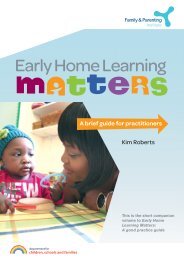Children with Disabilities
Children with Disabilities
Children with Disabilities
Create successful ePaper yourself
Turn your PDF publications into a flip-book with our unique Google optimized e-Paper software.
(continued from p. 3)<br />
the right to express their views and participate<br />
in making decisions, and the right to enjoy equal<br />
protection under the law. They belong at the<br />
centre of efforts to build inclusive and equitable<br />
societies – not only as beneficiaries, but as<br />
agents of change. After all, who is in a better<br />
position to comprehend their needs and evaluate<br />
the response?<br />
In any effort to promote inclusion and fairness,<br />
children <strong>with</strong> disabilities should be able to enlist<br />
the support of their families, disabled people’s<br />
organizations, parents’ associations and community<br />
groups. They should also be able to<br />
count on allies further afield. Governments have<br />
the power to help by aligning their policies and<br />
programmes <strong>with</strong> the spirit and stipulations of<br />
the CRPD, CRC and other international instruments<br />
that address or affect child disability.<br />
International partners can provide assistance<br />
compatible <strong>with</strong> the Conventions. Corporations<br />
and other entities in the private sector can<br />
advance inclusion – and attract the best talent<br />
– by embracing diversity in hiring.<br />
The research community is working to improve<br />
data collection and analysis. Their work will help<br />
to overcome ignorance and the discrimination<br />
that often stems from it. Furthermore, because<br />
data help to target interventions and gauge their<br />
effects, better collection and analysis helps in<br />
ensuring an optimal allocation of resources and<br />
services. But decision-makers need not wait for<br />
better data to begin building more inclusive infrastructure<br />
and services: As some have already<br />
found, inclusion involves and benefits entire<br />
communities, and its elements can be applied to<br />
new projects across the board. All that is needed<br />
is for these efforts to remain flexible so they can<br />
be adapted as new data come to light.<br />
The next chapter of this report discusses exclusion<br />
and the factors that propagate it, along <strong>with</strong><br />
some philosophical and practical fundamentals<br />
of inclusion. Subsequent chapters – each of<br />
which applies the same approach of exploring<br />
barriers as well as solutions that show<br />
promise – are dedicated to specific aspects of<br />
the lives of children <strong>with</strong> disabilities. Chapter 3<br />
examines the health, nutritional and educational<br />
services that can provide a strong foundation<br />
on which children <strong>with</strong> disabilities can build<br />
full and fulfilling lives. Chapter 4 explores the<br />
opportunities and challenges of ensuring legal<br />
recognition and protection against exploitation<br />
or abuse. Chapter 5 discusses inclusion in the<br />
context of humanitarian crises.<br />
Many of the deprivations endured by children<br />
<strong>with</strong> disabilities stem from and are perpetuated<br />
by their invisibility. Research on child disability<br />
is woefully inadequate, especially in low- and<br />
middle-income countries. The resulting lack of<br />
evidence hinders good policymaking and service<br />
delivery for children who are among the most<br />
vulnerable. Therefore, Chapter 6 of this report<br />
examines the challenges and opportunities<br />
confronting researchers – and ways in which<br />
children <strong>with</strong> disabilities can be rendered visible<br />
through sound data collection and analysis.<br />
Chapter 7, which concludes this edition of The<br />
State of the World’s <strong>Children</strong>, outlines necessary<br />
and feasible actions that will enable governments,<br />
their international partners, civil society<br />
and the private sector to advance equity through<br />
the inclusion of children <strong>with</strong> disabilities.<br />
Wenjun, 9, walks <strong>with</strong> her foster mother in China.<br />
© UNICEF/China/2010/Liu<br />
INTRODUCTION<br />
9






